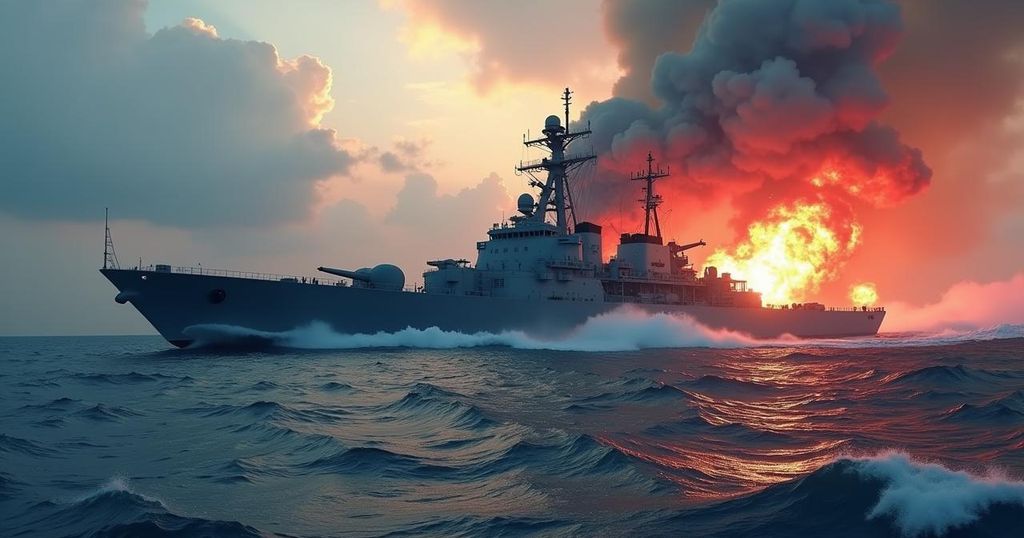Concerning Encounter: Chinese Missile Boat Shadows Philippine Vessel in South China Sea
A Chinese missile boat shadowed a Philippine vessel, the BRP Datu Romapenet, while it was en route to deliver supplies at Half Moon Shoal, located within the Philippines’ exclusive economic zone. Analyst Chester Cabalza termed the incident as alarming, indicating a show of force from China. The engagement is notable as it marks the first sighting of a Type 22 missile ship in this area, raising concerns about increased tensions in the already volatile South China Sea.
On Friday, a Chinese navy missile vessel shadowed a Philippine civilian ship in an unprecedented and concerning encounter. The Philippine ship, the BRP Datu Romapenet, which is operated by the Bureau of Fisheries and Aquatic Resources (BFAR), was in transit to Half Moon Shoal in the South China Sea, delivering supplies to local fishermen. Half Moon Shoal is located within the Philippines’ exclusive economic zone, approximately 60 miles off the coast of Palawan. Reports from ABS-CBN News confirmed that the vessel was pursued by a Houbei-class guided-missile craft, identifiable by its distinctive wide, camouflaged hull. During the surveillance, the Chinese missile craft reportedly directed a laser at a nearby fisheries bureau plane on three separate occasions. Additionally, a Chinese coast guard vessel was observed operating in proximity to the incident. Chester Cabalza, founder of the International Development and Security Cooperation think tank based in Manila, labelled the encounter as alarming, emphasizing that it marked the first sighting of a Type 22 missile ship within the Philippine EEZ. He stated, “This incident is alarming because a missile ship shadowed our BFAR ship,” interpreting the event as a deliberate act of intimidation by China. While it is common for the People’s Liberation Army Navy to operate in adjacent waters, direct engagement by a foreign naval warship represents a notable escalation in the already heightened tensions in the Spratly region. Historically, confrontations between Chinese vessels and Philippine ships have predominantly involved China’s coast guard, which has employed aggressive tactics such as water cannons and military-grade laser attacks against Philippine coast guard personnel. Both China’s Foreign Ministry and the Armed Forces of the Philippines were unavailable for immediate comment on the incident. The ongoing disputes between China and several Southeast Asian nations, particularly the Philippines, continue to complicate regional stability, especially given China’s assertions of sovereignty over much of the South China Sea based on purported historical rights. This territorial claim is at odds with a 2016 ruling by an international tribunal which invalidated such claims. Despite this, China has refused to accept the ruling. The United States remains a significant ally of the Philippines; President Joe Biden emphasized the unwavering commitment of the U.S. to its Mutual Defense Treaty with the Philippines. Recent discussions between U.S. and Chinese defense officials also touched upon the critical issues surrounding the South China Sea, underscoring the ongoing geopolitical complexities of the region.
The South China Sea has been a focal point of escalating tensions due to overlapping territorial claims by several countries, including China, the Philippines, Vietnam, and others. China asserts sweeping sovereignty over most of the sea’s features, a stance that has faced significant international scrutiny, particularly following a ruling by an arbitral tribunal in 2016 that invalidated China’s expansive claims. The region’s importance is underscored by its strategic shipping lanes and rich marine resources, making it a contentious ground for competing maritime interests. As the Philippines bolsters its claims under President Ferdinand Marcos, Jr., such encounters with Chinese vessels are likely to continue, emphasizing the need for vigilance and strategic diplomacy.
In conclusion, the encounter between the Chinese missile boat and the Philippine ship highlights the precarious nature of maritime disputes in the South China Sea. This incident not only raises concerns regarding the aggressive tactics employed by China in asserting its claims but also signifies a potential escalation in confrontations that could impact regional security. With the U.S. backing the Philippines under its Mutual Defense Treaty, the situation remains highly sensitive, requiring close monitoring as diplomatic discussions continue to unfold.
Original Source: www.newsweek.com







Post Comment